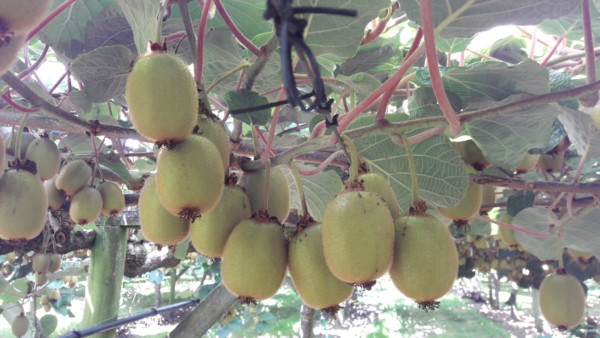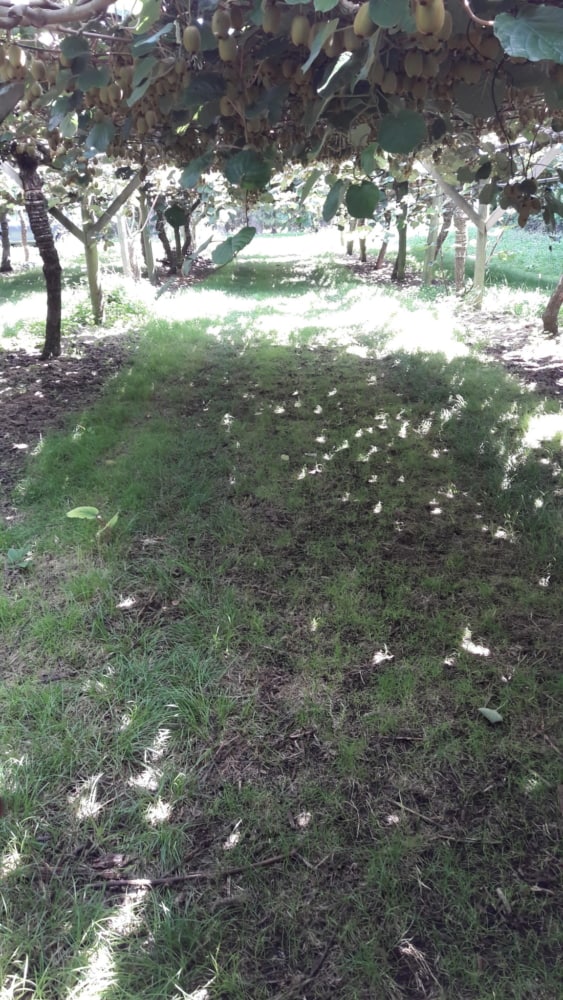Kiwifruit – heading to harvest!
As first seen in the Orchardist, March 2018
Ruth Underwood, Horticultural Consultant, Fruition Horticulture (BOP)
At this stage of the season it is close to kiwifruit harvest time but there’s still things we don’t know about how the rest of the season will pan out and the crop results! Doing the basics well – including timeliness – is still a key to orchard performance.
I’m writing this during the hot mid-February weather. We’ve got between 4 weeks and 3 months left of this growing season, depending on your varieties and location. In this article I’ll focus on things done at this stage of the season that can still influence your 2018 harvest results.
What’s coming up?
The seasonal weather outlook is for autumn conditions to be slightly warmer and wetter than usual. In the Bay of Plenty it’s been a wet summer and there is more canopy and grass growth than we often have at this stage of the season. Timing of fruit maturity is unknown as monitoring has just begun – but harvest can’t always be later than we expect as it was in the last two seasons!
What can we influence now?
Thinning can reduce your reject rate and may improve fruit size. Late season thinning improves the crop being presented to the packhouse. Many packhouses have a penalty when the level of rejects gets above a certain level – often 10%. Thin and count rejects removed to gauge rejects level in bays where you know the number of fruit. You’ll often only find about half the rejects present, even with a slow and careful thin of the bay, so if your ‘test thin’ comes out at 5% rejects you may well have 10% rejects in the bay. Damage from late-season storms may increase your reject rate further. My impression is also that fruit shape problems are accentuated when the fruit is larger. That can mean a fruit slightly square but in grade when you thinned in January, can become out of grade if it grows more than you expected through the rest of the season.
We don’t know how much fruit growth will occur this autumn although we know fruit growth slows markedly as daylight reduces. Daylight hours reduce independent of weather conditions, with late March being the midpoint between the longest and shortest days.
The multipliers published by Zespri indicate typical increases in fruit size in or dry matter. They work from full bloom date, which varies from orchard to orchard. Towards the end of the growing season, as you’d expect, the rate of fruit growth slows markedly and there is usually little fruit size increase from about early May for green kiwifruit and mid-April or so for Gold3 kiwifruit. You can use these multipliers to work out the smallest fruit in your crop likely to make it to saleable size. That gives you a reference point for thinning to remove undersized fruit. There is likely some benefit to the size of the remaining fruit by removing the smallest, but the main benefit will be to your packout as recorded at the packhouse. Remember to keep calibrating the cut-off point. If your fruit size is large, removing the smallest fruit by eye may be removing saleable fruit!
Fruit blemishes may be hard to spot among bunches of fruit
 Rejects aren’t always easy to spot. Fruit shape is easier to see quickly than blemishes or Hayward marks which may only be visible from one angle or hidden behind neighbouring fruit. If your packout history shows mis-shapen fruit being your key reject and your rejects have been over about 15% in recent years, then ‘go hard’ removing misshapen fruit this time. Keep checking against the grading criteria but don’t leave the borderline ones on the vine. In contrast, if your packhouse rejects are regularly 5-8% or less, be careful not to thin too hard as for example 50% of rejects being misshapen isn’t a big deal when the reject rate is so low in total. If results from the first areas picked show higher than expected reject rates, consider putting someone on the bins removing obvious rejects if it’s not feasible to do another thin.
Rejects aren’t always easy to spot. Fruit shape is easier to see quickly than blemishes or Hayward marks which may only be visible from one angle or hidden behind neighbouring fruit. If your packout history shows mis-shapen fruit being your key reject and your rejects have been over about 15% in recent years, then ‘go hard’ removing misshapen fruit this time. Keep checking against the grading criteria but don’t leave the borderline ones on the vine. In contrast, if your packhouse rejects are regularly 5-8% or less, be careful not to thin too hard as for example 50% of rejects being misshapen isn’t a big deal when the reject rate is so low in total. If results from the first areas picked show higher than expected reject rates, consider putting someone on the bins removing obvious rejects if it’s not feasible to do another thin.
Selective canopy work in dark patches is worthwhile to improve airflow and light interception by the leaves near to the fruit. The fruit skin should be ‘tough’ enough to allow work in the canopy, but still check damage isn’t occurring while you’re doing this work.
Trimming the edges of male vines again may help improve light access onto the female vine leaves with little risk of fruit damage.
Also look for a burst of regrowth a few weeks after each dollop of autumn rain. Those late shoots won’t develop quickly enough to help fruit size or dry matter so they’re likely hindering both by diverting vine resources away from the fruit. The late shoots aren’t a good choice for fruiting wood next season either and they are simpler to remove when they are young and brightly coloured so stand out in your canopy.
Girdling vine trunks to assist fruit dry matter levels has become a well-established and successful practice. Check girdles are healing well and that you’ve noted the dates each block was girdled.
For young vines, keep up the vine training. Patiently directing vine growth into the permanent vine framework and into wood that you can use to carry fruit in the next couple of seasons pays off. We’ve all found older vines with bare sections of the leader and wished they had more growth points – that’s the problem you’re preventing with your attention to detail on the young vines.
Monitoring of fruit dry matter over the lead up to harvest will indicate how levels are tracking. If your fruit size or dry matter is still lower than you’d like at harvest, many packhouses have some ability to help. Some people have had success selectively picking fruit from an area of the vines with higher dry matter or just the fruit sizes where the dry matter met clearance standards. The rest of the fruit can be monitored with a view to strip pick the balance a few weeks later. Last season, packhouses that didn’t have their own equipment to sort based on dry matter were often able to use other facilities to extract the marketable fruit from low dry matter crops.
This is the time of year to calmly check things are ready for harvesting the orchard and marketing of your fruit. These tasks include:
Late season canopy work may be needed in dense parts of the canopy; keep mowing and weed control up to date

- Checking maps are current to your orchard layout and maturity areas.
- Checking contractors have their appropriate registration and your packing and picking agreements and equipment are in place.
- Ensuring crop protection programme records are up to date and in accord with requirements.
- Checking the loadout area and tracks are ready for the harvest traffic.
- Within the orchard, filling in rabbit holes, checking any open drains are clearly marked, and tying up any loose wires or bracing buckling structures.
- Keeping mowing and weed control up to date.
- Scheduling the last crop protection activities including clean-up sprays and arranging Psa protection after harvest. You might have to delay post-harvest crop protection sprays if neighbouring blocks are not yet picked.
- Checking over staff facilities – toilets and handwashing facilities are important!
If you’ve done things differently in parts of the orchard, before harvest make a review of their effects if you won’t get these in maturity area results. This will help gauge impacts of your changes, so you can decide on your management in future seasons. Your maturity areas may need adjusting. It’s to your advantage for each maturity area to be as uniform as possible in terms of site factors, vine age, set-up and performance level and also your husbandry practices in the area. Husbandry that might affect uniformity of the fruit includes supplementary pollination and girdling strategy.
If you’ve got trials in the orchard run by an outside organisation, check their plans for harvesting and keep them in touch with your maturity results and likely harvest dates. Make sure your picking team know what to do in any areas marked as trials.
If you’ve got areas of the orchard where vines were affected by the wet conditions through the 2017 winter or in recent late-summer storms, I’d suggest picking those areas earlier rather than later in the harvest period to allow the vines more time to recover after the fruit is off.
All the best for your harvest. Each season brings its own characteristics which interact with our husbandry practices. Inevitably there are a few things to tweak or do differently in the future. That forms part of the basis for increasing industry performance and keeps growing interesting!